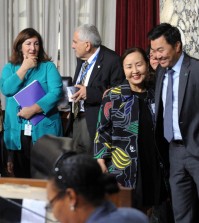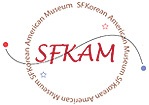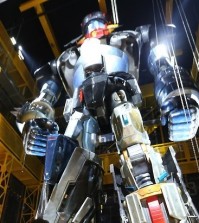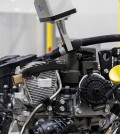- California Assembly OKs highest minimum wage in nation
- S. Korea unveils first graphic cigarette warnings
- US joins with South Korea, Japan in bid to deter North Korea
- LPGA golfer Chun In-gee finally back in action
- S. Korea won’t be top seed in final World Cup qualification round
- US men’s soccer misses 2nd straight Olympics
- US back on track in qualifying with 4-0 win over Guatemala
- High-intensity workout injuries spawn cottage industry
- CDC expands range of Zika mosquitoes into parts of Northeast
- Who knew? ‘The Walking Dead’ is helping families connect
Lee Bok-hyung’s Museum marks 20th anniversary in Korea
Lee Bok-hyung’s Museum marks 20th anniversary
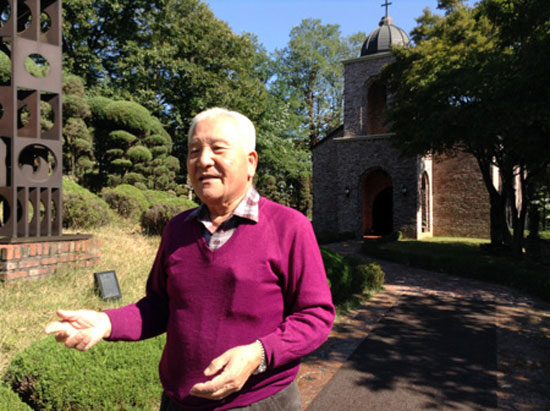
Retired ambassador Lee Bok-hyung speaks during an interview at the Latin American Cultural Center and Museum in Goyang, Gyeonggi Province, Oct. 16. (Korea Times photo by Kim Se-jeong)
By Kim Se-jeong
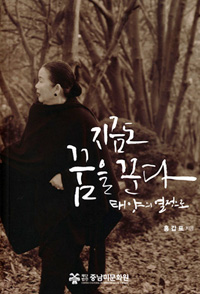
Ambassador Lee’s wife
Kappy Hong’s memoir “I Am
Still Dreaming” was published
recently in which she recounts challeges faced in the making of the Latin American Cultural Center and Museum.
As a retired Korean diplomat, Lee Bok-hyung is well known in the Latin American community in Seoul.
His postings in Latin America in clude Mexico, Argentina, the Dominican Republic and Costa Rica over a span of 18 years. His broad and in-depth knowledge about the region’s geopolitics, economies, music and art and his command of Spanish have made him a mentor for Latin and Korean diplomats and an advisor to domestic politicians and businessmen.
Yet, what he is most identified with is the Latin American Cultural Center and Museum.
Celebrating its 20th anniversary this week, the center, comprised of a museum, a gallery, a sculpture garden, Catholic chapel, a mural and a restaurant, mirrors the epic work achieved by Lee and his wife Kappy Hong.
Opened in 1993, the center in Goyang, Gyeonggi Province, has become a popular destination for visitors, domestic and foreign. It has provided kindergarteners and primary school children with a venue for an autumn-day picnic, and groups of young adults with a place to enjoy mid-day excursions.
During sunny weekends, the number of visitors reaches between 1,000 and 2,000, the ambassador said. The museum also has a seminar room where he lectures about Latin America to groups of visitors. It has also become a must-see for Latin American politicians and civil servants who visit Korea.
The cultural center compound is also the couple’s home. They are constantly busy with maintaining the place, rearranging the museum and gallery, and planning new events.
Speaking with The Korea Times last week, Lee said, the couple now think more about the future of the non-profit center so that the original idea of raising awareness of Latin America among the Korean public won’t fade away in their absence.
A museum wasn’t exactly what the couple had in mind when they bought the land in 1970.
“We were dreaming about a romantic rural life after retirement,” Lee said.
He said the project would not have been possible without his wife Hong.
As an avid collector of antique silverware and other items since a young girl, his wife continued collecting while abroad with her husband.
The idea of constructing a museum and donating it to a local community came later.
The museum opened in 1994, one year after Lee’s retirement. The museum houses all the artifacts that the couple had collected overseas. The other collections were purchased later, donated, or commissioned. In 2011, a Latin chapel also opened on the compound, adding stature to the cultural center.
The couple had properties in Seoul, which were used as loan guarantees, but they were not without financial challenges. The Asian IMF crisis hit the couple hard. They had just taken out a loan to build a gallery in 1997. The interest rate rose to 25 percent.
In a recently-published memoir “I am Still Dreaming,” Hong elaborated on the challenge she faced in the making of the cultural center. At one point, she even labeled the project as a “stupid” idea.
People who know Lee cherish his work.
Paraguayan Ambassador Ceferino Valdez, the longest-serving Latin American diplomat in Korea, calls him visionary. “Now, everyone looks at the region for opportunities. But 20 years ago, not many people talked about Latin America. He saw that 20 years ago.”
Valdez also recognized Hong’s dedication. “When I say Ambassador Lee, I am referring to both. She is a great woman. They work together.”
A board meeting which will discuss the future of the cultural center will take place in the near future, said Lee.
“We’re getting older, now we have to decide what this place will look like (in 20 years),” he said. His wife turns 80 this year, and Lee is two years older than her.
The center will celebrate its 20th anniversary on Friday with his friends and colleagues invited. Lee is preparing for a special exhibition featuring Mexican artists Jose Maria Velasco and Guadalupe Posada, and Panama’s Cuna Indians’ Mola collection.
For more information about the center, visit www.latina.or.kr.







